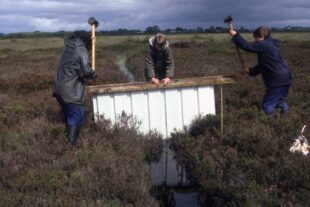The job title ‘environmental specialist’ conjures a certain image, and a perception of the types of things we do.
Even a quick image search of the term via google will show you a catalogue of people looking wistfully at a beaker of water, usually while stood in a stream.
I do understand the power of a good photo in promoting environmental endeavours. My earliest publicity job was a starring role in the installation of a dam for the Nature Conservatory Council, thanks to my dad’s role as reserve manager. .

And I’m not saying that environmental monitoring – checking that our impact on the air, water, and land is as low as possible - isn’t part of the job. Of course, it is. And it’s something that we’ve been doing at Sellafield for more than half a century.
But the real value of our job doesn’t lie in checking whether we’ve had an impact on the environment after the fact, it is in being at the forefront of identifying ways to minimise that impact in the future.
Nuclear: the ultimate test for graphene
We have various R&D projects in flight that have the potential to improve our environmental impact. One of the most exciting (for me) is the potential use of graphene in concrete.
As home to one of the biggest portfolios of major project construction in the country, we expect to use a lot of concrete at Sellafield over the next 20 to 30 years.
That concrete has its benefits. It’s robust enough to help keep the nation’s stockpile of special nuclear materials secure and safely house containers of radioactive waste.
Its environmental credentials aren’t so impressive. Greenhouse gas emissions from concrete – mainly from the energy used to make cement – are high. Anything we can do to reduce the amount we use, or change the way it is made, could be a real game changer on the carbon dioxide front.
Adding graphene to a concrete mix, according to our colleagues at the University of Manchester, could reduce our carbon emissions from concrete. For example it has the potential to set harder and faster than a mix that doesn’t contain graphene which might mean we can reduce the cement content in the concrete, or even reduce the amount of concrete we need to use, and importantly the finished construction will still do what we need it to.
Testing the use of graphene is the only way to prove that it can deliver the impact that we think it can. It’s very early days in the project, but the scale of construction we have at Sellafield could mean we have the perfect test bed.
The task of finding an appropriate test environment (the test wouldn’t be done on a project where we’re building a facility that will hold nuclear materials in the future), working with the University, with our suppliers and with wider industry, and engaging with our regulators to ensure that everything is done in line with regulations, are just some of the challenges that make the role of an environmental specialist at Sellafield so interesting and rewarding.
Heat capture and mushrooms
Other research and development projects include looking at how we might be able to reduce our energy usage – and therefore our carbon footprint – by capturing waste heat so that it can be used elsewhere on the site.
Some of our buildings at Sellafield are used to store radioactive fuels and waste. That material emits heat and so the buildings need to be kept cool. That in turn means that we discharge heat into the environment.
What if, in the future, we could capture that heat and use it across the site instead?
Looking further into the future, another fascinating emerging concept is the use of ‘grown’ materials, using fungus to actually grow a material that can be used with minimal processing and that will ultimately biodegrade. If we can apply materials like this to our site, can we reduce our waste burden?
Monitoring our impact
Yes, monitoring the environment, and then analysing the results so that the organisation can understand its impact, spot trends, and identify opportunities to reduce that impact is very much part of the job of an environmental specialist.
But is it also so much more than that.
Sellafield is a place where you can make an immediate positive difference to the planet – helping to create a clean environment for future generations. It is also somewhere where you can be at the cutting edge of environmental protection.
If you’d like to join James and the rest of the environmental team, check out our environmental specialist and advisor vacancies.
Recent Comments